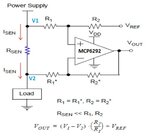gravi
Full Member level 2
- Joined
- May 30, 2006
- Messages
- 128
- Helped
- 10
- Reputation
- 20
- Reaction score
- 10
- Trophy points
- 1,298
- Location
- Hyderabad, India
- Activity points
- 2,452
Hi,
We are trying to interface Shunt 75mV at 500 Amps AD/DC load to PIC24FJ128GC006 microcontroller,
Can we connect shunt directly to Micro controller CH0+ and CH0- pins or do we need any circuit in between. PIC24FJxxxGCyyy series micro controllers have inbuilt 16 bit Sigma delta ADC. So considering the resolution we think that 0.1 milli Volts can also be monitored. But Can you suggest me the best circuit to interface.
Thanking You,
Ravi
We are trying to interface Shunt 75mV at 500 Amps AD/DC load to PIC24FJ128GC006 microcontroller,
Can we connect shunt directly to Micro controller CH0+ and CH0- pins or do we need any circuit in between. PIC24FJxxxGCyyy series micro controllers have inbuilt 16 bit Sigma delta ADC. So considering the resolution we think that 0.1 milli Volts can also be monitored. But Can you suggest me the best circuit to interface.
Thanking You,
Ravi


